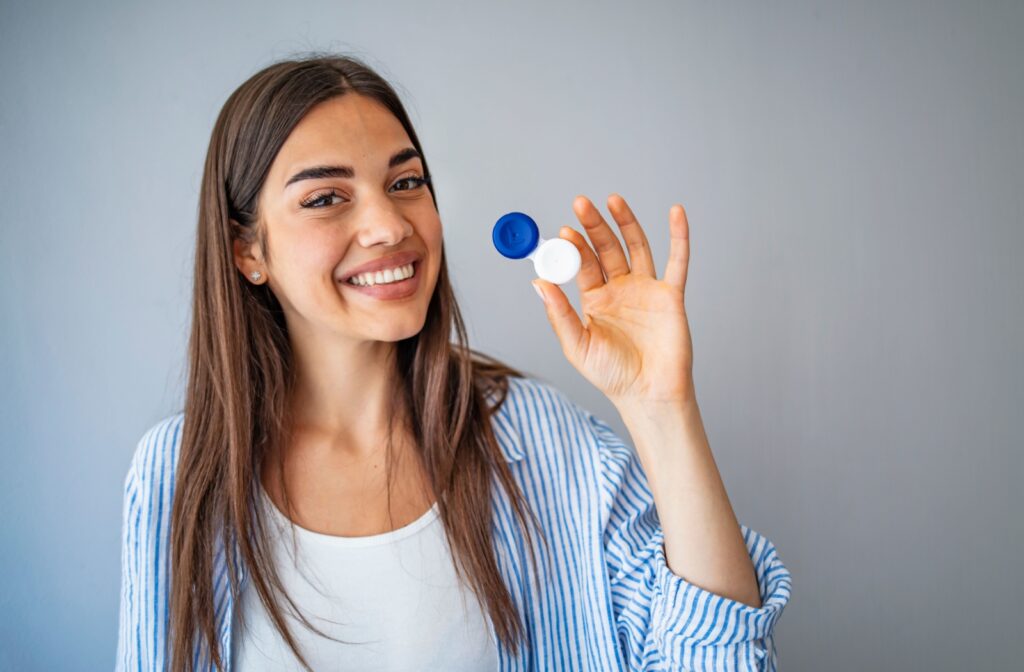You might be surprised to learn that glasses and contact lenses don’t use the same prescriptions and actually require distinct eye exams. If you’ve never been fitted for contacts, this might make you curious about what’s involved in exams for contact lenses. So—let’s find out!
A contact lens exam includes a routine eye exam, then involves your optometrist measuring the shape and the curvature of your eyes and determining which prescription you need, which brand of lens will fit your eyes, and which type of lens you should use. All of these factors are crucial for ensuring that you have comfortable and effective vision.
The Routine Eye Exam
A contact lens exam begins with a routine eye exam. The normal elements of this exam include:
- Determining your eye health: To ensure that your eyes are healthy, a number of tests will be performed that check for a range of different eye conditions.
- Testing your visual acuity: Your vision will be tested with an eye chart to determine how sharp your vision is, whether you need a corrective prescription, and how strong that corrective prescription should be.
The Contact Lens Exam
After the routine part of your exam, your eye doctor will need to collect information about your eye health, your contact lens preferences, and the dimensions and measurements of your eyes.
Your Contact Lens Preferences
Your eye care professional will likely ask you about your lifestyle and preferences. This will allow them to determine what kind of lens might be the best fit. Some possible questions include:
- What kind of lifestyle you lead.
- Whether you’re interested in daily disposable or overnight wear contact lenses.
- Whether you’d prefer soft lenses, rigid gas permeable lenses, or gas permeable lenses (Ask about the difference if you aren’t sure!)
- If you are over 40, your eye doctor may also ask about correcting vision problems that are associated with age, for instance, presbyopia.
Based on your answers to these questions, your eye doctor will get a sense of your needs and preferences.
Measuring Your Eye
Contact lenses aren’t one-size-fits-all. On the contrary, each lens is fitted so as to optimize corrective effect and minimize any possible discomfort. Your eye care professional will need to examine various aspects of your eye. Some of these aspects may include:
- Measuring your pupil and iris: Measuring your pupil (the dark, central part of your eye) and your iris (the colored part around it) can help identify contact lenses that both fit and look good on your eye. This step is especially important if you’re interested in lenses that change your eye color.
- Measuring your cornea: The size and curvature of your cornea (a transparent layer of the eye located over your pupil and iris) are important for selecting lenses that will give you the sharpest possible vision. If you have an astigmatism, you may need a special kind of contact lens known as toric contact lenses.
- Checking your tear film: Contact lenses are only safe if your eyes make enough tears to support them. If your eyes are too dry, contact lenses may not be appropriate.
- Evaluating the surface of your eyes: The health of your cornea may be assessed in order to ensure that contact lenses are a good fit for you. You may also be asked to wear trial lenses so that your optician can determine how lenses fit over your eyes.
- Evaluating the effects of wearing contact lenses: After your initial fitting, you’ll need to make one or more follow-up appointments to confirm that your lenses fit, that your vision has been corrected, and that your lenses are safe and comfortable. Only then will you get your prescription.

Your Prescription
Once you’ve completed your exam and any follow-up appointments, your eye doctor will provide you with a prescription. Because contact lenses are regulated medical devices, a prescription is necessary in order to buy them.
Your prescription will include a number of elements, including:
- The brand of the lenses
- The curve of the lenses
- The diameter the lenses
- An expiration date for purchasing replacements
Your prescription may also include specific instructions for wear, e.g., how often to replace your lenses or whether you should wear them overnight. Make sure to only wear your contact lenses as prescribed—your prescription was carefully considered in order to keep your eyes healthy and safe.
Learn More About Wearing Contact Lenses
For many people, contact lenses offer a sense of freedom and style that can’t be captured by glasses. For other people, glasses and contacts serve a complementary function, with each being best for different activities and/or different times of day.
Whatever the case may be, you should now have a good grasp of what’s involved in a contact lens exam. If contacts pique your interest, or if you have questions about any other eye care topic, book an appointment with us today. At Toronto Centre Eye Care, we’re eager to help you meet your vision goals.



